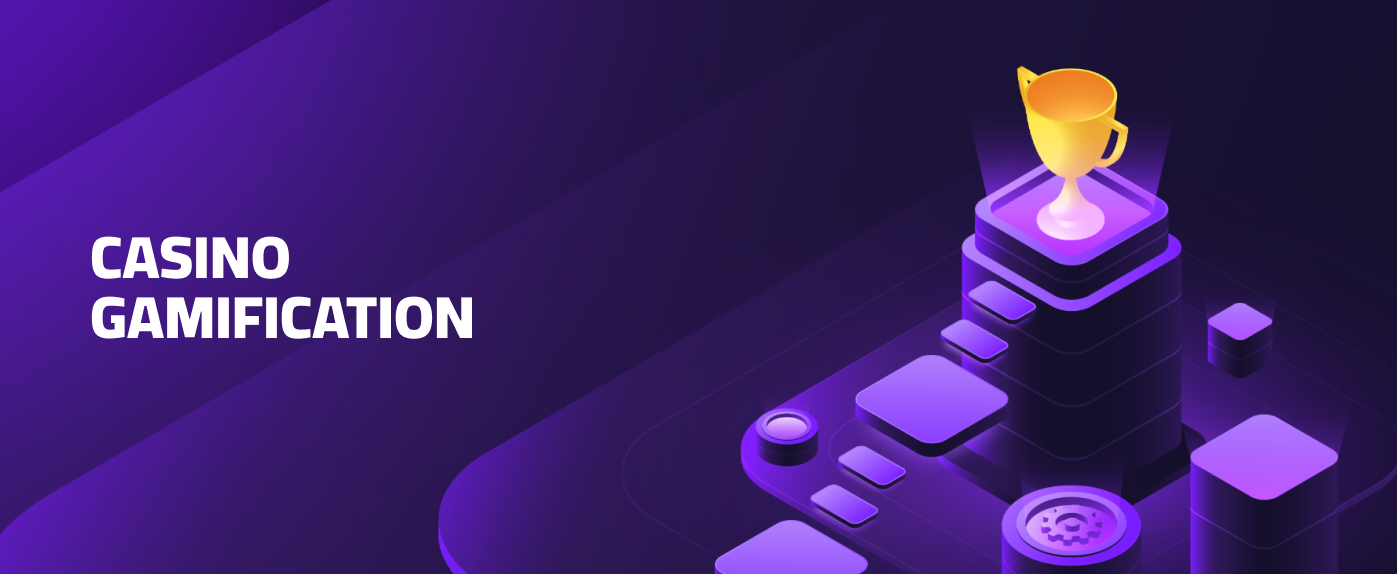
How Casino Gamification is Shaping the Future of iGaming?
In recent years, casino gamification has become an almost irreplaceable component of the iGaming industry. Its success is largely due to the numerous benefits it brings, especially when it comes to enhancing player satisfaction and, consequently, retention. To better understand casino gamification, we need to look at a few key factors. Our article focuses precisely on how gamification works in online gambling, providing insight into its different elements, such as unlockable content, tournaments, loyalty programs, and more.
What is Gamification?
The term gamification doesn’t relate specifically only to the iGaming sector, but it’s become increasingly important in this continuously evolving industry. Mainly because it applies so well. Gamification is, in fact, the use of game-like features in non-gaming contexts to boost user engagement and motivation. This means applying points, levels, achievements, and competitions to traditional online gambling experiences.
The goal is to make gameplay more interactive, rewarding, and consequently more immersive. Spinning reels and placing bets can only entertain players so far, but with gamification, they can earn badges and climb leaderboards. This turns passive gaming into an engaging experience.
How Does Gamification Work in iGaming?
Gamification in iGaming involves the use of game-like features, such as badges, points, and leaderboards to climb. The player isn’t simply drawn to the chance of winning a spin or bet, but to playing smart and strategically to ensure extra prizes.
Most platforms offer a few common and recurring elements of gamification, which are fairly popular. Here are the most important ones no online casino can ignore.
- Quests and challenges. When the player completes a quest or a mission, they receive a certain number of points. For example, spinning the reels 10 times will earn you 5 points.
- Badges and achievements. Completing specific actions, such as reaching a certain number of spins, awards the player a badge that can be different based on the level they’re on. These achievements create a sense of accomplishment and status.
- Leaderboards. Players compete against each other for rankings, which boosts community spirit.
- Points and levels. Players gain points by performing specific actions, from playing and depositing funds to completing challenges. This unlocks bonuses and other perks.
- Progress bars. These show users how close they are to completing a quest or unlocking a reward, which encourages continued play.
- Storylines. Some online casinos build narratives around games, turning the player into a “hero” in a larger journey.
- Team or clan features. This is a key social element of gamification, where players collaborate to reach certain prizes or levels.
All these features can be provided on their own or as a mix of opportunities. The result is the same: improving players’ experience and turning ordinary gambling sessions into exciting adventures.
Gamification Examples
The best way to understand how gamification solutions work in practice is to look at how they are used in different sectors of the iGaming industry.
Gamification in iGaming
Casino gamification goes far beyond flashy slots and promotions. iGaming platforms often integrate a casino affiliate system into their operations. This means not only point-based rewards and level-ups, but also milestone badges to motivate affiliates and track performance. Additionally, iGaming CRM (Customer Relationship Management) tools are used to trigger challenges, achievements, and personalized missions. By turning a regular gaming session into a more dynamic, goal-driven adventure, operators boost engagement, increase retention, and create a more immersive and rewarding experience for every user involved.
Gamification in Online Gambling
Gamification in casinos has revolutionized the way players interact with every game. Instead of simply spinning reels and placing bets, players now engage with layered gameplay that includes missions, progress bars, multi-levels, unlockable content, and in-game rewards. This doesn’t concern only the platforms, but also the specific games. Many providers now go beyond the original purpose to build slots with elements like daily challenges, mini-games, and story-driven features. The result is a gambling experience more similar to video games.
These game mechanics keep players entertained for longer periods because they encourage daily logins and repeated play, creating the same emotional connection as other means of entertainment. Leaderboards and competitive events further enhance the social aspect, giving players a reason to return and climb the ranks. Ultimately, gamification in online gambling transforms passive gameplay into an interactive journey that works alongside the thrill of betting to enhance the overall experience on the platform.
The Impact of Gamification on Casino Games
Traditional casino games rely on the thrill of betting and gaming in itself, but in a fast-developing environment such as the iGaming industry, that’s no longer enough. That’s why more and more operators have moved toward online casino gamification.
The major impact gamification has had on these platforms concerns:
- Player engagement. A more interactive, adventure-driven journey compels the player to play more and deposit more funds.
- Demographics. Because it makes online casino games more similar to video games, gamification attracts younger generations, specifically Millennials and Gen Z, who are more interested in a full experience than in simple monetary rewards.
- Player retention. Special promotions such as daily login bonuses and tiered loyalty programs encourage players to return more often.
- Community. Gamification also includes social media, which creates a solid community around the brand, enhancing the gaming experience and fostering long-term loyalty.
Casino Gamification: How to incorporate (Ways)
Incorporating gamification into an online casino is about crafting deeper, more immersive experiences, which can be done in multiple ways. Here are some of the most effective gamification techniques.
Narrative Storytelling
Narrative storytelling transforms traditional gameplay, which is made of spinning reels and placing bets, into whole storylines that make the player feel like a hero. Chasing a bigger goal instead of a simple payout enables the player to stay engaged longer and to return more often. The story arcs are also built in the game, so that the player needs to not only place a bet and spin the reels, but also follow character-driven arcs, unlocking new adventures at every turn. The emotional investment in the character’s journey compels more action and more engagement, turning passive casino users into enthralled participants who will keep thinking and talking about the game even offline.
Unlockable Content and Levels Progression
Unlockable content and leveling up are two of the most commonly used tools in casino gamification. They’re particularly important because they give players something to look forward to besides the simple chance for a payout. Users are encouraged to progress through levels to unlock new features, which gives them a sense of achievement and keeps the gameplay exciting. They can get special bonuses, access to special tournaments, free spins, higher withdrawal limits, and deposit limits just by completing specific tasks.
Badges and Achievements
Badges and achievements are classic engagement tools used to recognize a player’s achievements. In the context of online gambling, they are visual accomplishments obtained for hitting milestones set by the casino. These can be in the form of spinning the reels a certain number of times, logging in for X days, completing in-game challenges, and so on. However, these badges aren’t simple icons that the player can display on their profile. They provide recognition, which triggers a sense of validation that compels them to continue playing.
Tournaments and Leaderboards
Achievements are usually paired with leaderboards in casino gamification. They not only track the player’s progress, but also show how they’re doing compared to others. This enhances the social aspect of gambling, inviting players to compete with their friends. Tournaments are some of the most common marketing and promotional opportunities for online casinos. By offering prizes, exclusive bonuses, and partnering with software providers, they can generate excitement and drive spikes in activity. As a result, the operator can gain new loyal customers.
Slot Games with RPG Elements
Traditional slot games were all about spinning the reels. That was the one and only feature. With time, they integrated more features that made the game more exciting. Now, operators are taking casino algorithms one step further and adding role-playing game (RPG) elements to the mix. These mechanics let players choose avatars, follow quests, complete missions, and progress through story-driven levels.
Virtual Reality (VR) Integration
One of the latest and certainly more relevant revolutions in technology and casino gamification is virtual reality integration. Players can now play in 3D environments, walking through virtual casinos, sitting at digital poker tables, or spinning slot machines as if they were truly in Las Vegas. VR-enabled games also offer fully immersive gaming experiences thanks to sensory depth and real-time interaction, making the game feel far more personal.
Loyalty and VIP Programs
Loyalty and VIP programs are the backbone of casino gamification. They are the original tools used to give players a sense of exclusivity through bonuses and tier-based rewards. As players accumulate points or reach certain milestones, they can climb tiers within the VIP programs, unlocking better perks along the way. This is a particularly important strategy to ensure players feel appreciated and their presence is rewarded. By creating an elite environment and offering escalating benefits, casinos encourage continued play while deepening user loyalty over time.
Psychology of Gamification: How Does it Work?
The psychology of gamification is rooted in well-established psychological principles that tap into human motivation and reward-driven behavior. The latter is based on elements such as progress-tracking, competition, and achievement, and it triggers dopamine responses. This gives players a sense of satisfaction that keeps them returning for more.
Concepts such as operant conditioning, goal-setting theory, and social comparison play a massive role in human behavior. By offering regular feedback (like badges or points) and clear goals (like levels or leaderboards), casinos keep users engaged and striving for the next milestone. Ultimately, gamification online casino is a carefully crafted psychological loop that keeps players coming back.
Pros and Cons of Gamification
While gamification casinos offer multiple advantages to operators and players, they also have some negative aspects. Let’s take a closer look at the pros and cons.
Gamification Advantages
Casino gamification has a strong positive impact on different aspects of the iGaming industry. In particular:
- It pushes player engagement because users feel more compelled to log in daily.
- It provides motivation through clear goals and rewards.
- It helps users develop new skills because gamification often requires multitasking.
- It encourages positive behavioral changes to gambling by pushing the player to focus more on entertainment than chasing monetary wins.
- It provides valuable insights into player behavior and preferences, allowing operators to tailor experiences to each user.
The ultimate result of gamification in the online gambling industry is happier players, improved retention, and smarter, data-driven decision-making for operators.
Gamification Disadvantages
While it’s a mostly positive strategy, iGaming operators can often encounter some specific challenges in incorporating gamification:
- Casino gamification software must be sophisticated enough to support dynamic systems such as tracking, rewards, and real-time events. This can be costly.
- Too many rewards, namely too many collaborations with brands, can reduce player motivation and, consequently, retention rates.
- Without compelling content or products, gamification for a casino doesn’t work.
- If it’s too heavily reward-based, players will focus solely on that goal.
- Not all players are motivated by the same elements, so before implementing casino gamification systems, it’s useful to conduct thorough research on player habits.
AI in Gamification
AI-driven personalization can help operators provide a fully immersive and engaging gaming experience, which is an important part of casino gamification. By analyzing player behavior in real time with artificial intelligence (AI), casinos can track preferences and habits, which allows them to tailor bonuses and other opportunities to each user. Whether it’s adjusting the difficulty of tasks, suggesting new games, or optimizing reward timing, AI helps create a uniquely immersive gaming experience. Moreover, it can make the environment safer by flagging high-risk profiles.
Future Trends in Gamification Strategies
Based on current trends in the online casino industry, we can predict that a few technologies and strategies will be pivotal in the future of gamification. In particular, the future landscape of the iGaming sector will see as protagonists:
- Blockchain technology. It can revolutionize casino gamification because it guarantees more transparency and security.
- Metaverse casinos. Here, users can interact with each other in 3D environments.
- Real-time rewards. Thanks to AI, operators can track progress in real-time, rewarding the players immediately.
- VR/AR integration. Virtual and augmented reality are part of metaverse casinos, and they allow users to walk in virtual casinos and sit at the tables as if they were physically there.
- Social gamification. Team-based challenges, group milestones, and shared leaderboards make gameplay more collaborative and competitive.
Conclusion
Gamification is no longer just a gimmick, it’s an essential strategy. For operators looking to develop casino gamification systems, it’s crucial to follow best practices: keep players engaged, reward achievements, and personalize every step of the journey. Done right, these tools don’t just entertain, they build loyalty, boost retention, and shape a distinctive casino brand experience.





